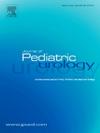The Koyanagi-Hayashi technique: An attractive technique for the severe hypospadias repair
IF 1.9
3区 医学
Q2 PEDIATRICS
引用次数: 0
Abstract
Introduction
In the armamentarium of techniques used to reconstruct proximal hypospadias, deciding which to use is difficult, and the reoperation rate is high whichever procedure is chosen. The Koyanagi-Hayashi techniqueis an alternative for urethral reconstruction.
Objective
The main objective of our study is to focus on this technique and to evaluate its results in the pediatric visceral and urogenital surgery department of Mohammed VI Oujda University.
Materials and methods
22 patients (median age 7,5 years, range 12 months–14 years) presented with proximal hypospadias and were operated by the same surrgeon according to the modified Koyanagi - Hayashi technique. The average of following's patients was 04 years. Ventral chordée is found in 17 children (77 %), the average measured degree during surgery (artificiat erection test) was 15° (12–20°). A micropenis (penis lenth less than 25 mm) was assessed in 12 (54.5 %) of cases, and scrotal abnormality was found in 10 (45.5 %) cases. Hormone therapy before surgery using dihydrotestosterone gel 2.5 % for one month has been indicated by the pediatric endocrinologist in patients with a micropenis (in patients aged less than 2 years) (12 cases, 54.5 % of cases). Stents or catheters were used in all patients.
The mediane age for surgery was 7.5 years (12 months- 14 years).2
Results
The success rate from the first intervention is 59 % with penile straightening obtained in all patients. The complications observed were: fistula (36 %), meatal stenosis (13 %) and partial failure of uretroplasty (9 %). These complications led to 10 surgical revisions: urethrocutaneous fistula 8 of cases or 36 %), dehiscence of the glans (2 cases or 9 %).
A third intervention was necessary in a single patient whose indication was glans dehiscence (4.5 %). The final result in our series is considered satisfactory.
Conclusion
The modified Koyanagi-Hayashi technique is an attractive alternative for proximal hypospadias repair with satisfactory results and considerable but manageable complications. In our series the success rate was 58.6 %. The main limit of this study is shortness of study (only 22 cases).
Koyanagi-Hayashi技术:重度尿道下裂修复的一种有吸引力的技术。
前言:在尿道下裂重建的技术中,选择哪一种方法比较困难,而且无论选择哪种方法,再手术率都很高。Koyanagi-Hayashi技术是尿道重建的另一种选择。目的:我们研究的主要目的是关注该技术并评估其在穆罕默德六世Oujda大学儿科内脏和泌尿生殖外科的效果。材料和方法:22例患者(中位年龄7.5岁,范围12个月-14岁)表现为近端尿道下裂,由同一位外科医生根据改良的Koyanagi - Hayashi技术进行手术。随访患者平均年龄为04岁。17例(77%)患儿发现腹侧脊索变,术中(人工勃起试验)平均测量度为15°(12-20°)。12例(54.5%)患者有小阴茎(阴茎长度小于25mm), 10例(45.5%)患者有阴囊异常。儿科内分泌科医生建议小阴茎患者术前使用2.5%的双氢睾酮凝胶进行激素治疗一个月(年龄小于2岁)(12例,54.5%)。所有患者均使用支架或导管。手术年龄中位数为7.5岁(12个月- 14岁)结果:首次干预的成功率为59%,所有患者均获得阴茎矫直。观察到的并发症有:瘘(36%),金属狭窄(13%)和子宫内膜成形术部分失败(9%)。这些并发症导致10例手术修复:尿道瘘8例(36%),龟头开裂2例(9%)。第三次干预是必要的,在一个患者的适应症是龟头开裂(4.5%)。我们系列的最终结果被认为是令人满意的。结论:改良的Koyanagi-Hayashi技术是尿道下裂近端修复的一种有吸引力的选择,其效果满意,并发症少但可控。在我们的系列中,成功率为58.6%。本研究的主要限制是研究时间短(仅22例)。
本文章由计算机程序翻译,如有差异,请以英文原文为准。
求助全文
约1分钟内获得全文
求助全文
来源期刊

Journal of Pediatric Urology
PEDIATRICS-UROLOGY & NEPHROLOGY
CiteScore
3.70
自引率
15.00%
发文量
330
审稿时长
4-8 weeks
期刊介绍:
The Journal of Pediatric Urology publishes submitted research and clinical articles relating to Pediatric Urology which have been accepted after adequate peer review.
It publishes regular articles that have been submitted after invitation, that cover the curriculum of Pediatric Urology, and enable trainee surgeons to attain theoretical competence of the sub-specialty.
It publishes regular reviews of pediatric urological articles appearing in other journals.
It publishes invited review articles by recognised experts on modern or controversial aspects of the sub-specialty.
It enables any affiliated society to advertise society events or information in the journal without charge and will publish abstracts of papers to be read at society meetings.
 求助内容:
求助内容: 应助结果提醒方式:
应助结果提醒方式:


